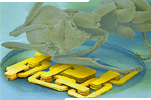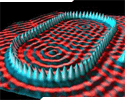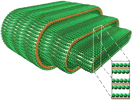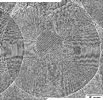Nanotech Futures
 The manipulation of matter at the atomic level is what nanotech is about. This revolution, at first in the materials sciences will lead to innovations in energy, health care, food production and small cost-effective devices with enormous power.
The manipulation of matter at the atomic level is what nanotech is about. This revolution, at first in the materials sciences will lead to innovations in energy, health care, food production and small cost-effective devices with enormous power.
In the background . . . nanotubes, spheres, and many other shapes constructed from carbon atoms, are providing applications ranging from nanoscale wiring for next generation computer chips, to molecular scale “medical devices’, and building blocks for complex structures
Quantum Corral
 Scanning tunnelling microscope (STM) picture of a stadium-shaped “quantum corral” made by positioning iron atoms on a copper surface. This structure was designed for studying what happens when surface electron waves in a confined region. Don Eigler, IBM. © American Institute of Physics
Scanning tunnelling microscope (STM) picture of a stadium-shaped “quantum corral” made by positioning iron atoms on a copper surface. This structure was designed for studying what happens when surface electron waves in a confined region. Don Eigler, IBM. © American Institute of Physics
 Biological Nanotubes . . . the next big breakthrough for medical applications? To the surprise of the researchers, these actin-membrane capsules spontaneously self-assembled from their constituents, and are hierarchically ordered, with different kinds of organization at different length scales. On the “mesoscopic” length scales that lie between the microscopic and macroscopic, these tubules have a ribbon-like tubule structure, with average widths of ~0.25 microns. The average lengths can be controlled, from as long as ~100 microns to short nano-capsules for possible drug delivery applications. (Gerard C.L. Wong and colleagues)
Biological Nanotubes . . . the next big breakthrough for medical applications? To the surprise of the researchers, these actin-membrane capsules spontaneously self-assembled from their constituents, and are hierarchically ordered, with different kinds of organization at different length scales. On the “mesoscopic” length scales that lie between the microscopic and macroscopic, these tubules have a ribbon-like tubule structure, with average widths of ~0.25 microns. The average lengths can be controlled, from as long as ~100 microns to short nano-capsules for possible drug delivery applications. (Gerard C.L. Wong and colleagues)
AFM . . . atomic force microscopy, has opened the door to “see” directly into the molecular world. There are many variations of the basic concept already being utilized, which allows for the surface of an object to be scanned or tracked with 3D precision well within the nanoscale of resolution. Above is pictured a cartoon diagram of a typical AFM probe head, left is pictured an actual AFM photograph of a “torroidal ring” of interwoven strands of DNA.
 This is a “cube” of folded DNA, one of a number of such molecular constructs being explored by Dr. Ned Seeman and collegues at New York State University. The ability to fold and assemble “geometric building blocks” of DNA has far reaching implications into biological computing, nano-scale biological machinery, and many other applications.
This is a “cube” of folded DNA, one of a number of such molecular constructs being explored by Dr. Ned Seeman and collegues at New York State University. The ability to fold and assemble “geometric building blocks” of DNA has far reaching implications into biological computing, nano-scale biological machinery, and many other applications.
 Using particle beams, a “carbon onion,” a structure consisting of nested fullerene-like balls, can be converted into a diamond. Here a growing diamond can be seen inside concentric graphitic layers. The diamonds can assume sizes of up to 100 nanometers. (Image – Florian Banhart, Max Planck Institute in Stuttgart, Germany.)
Using particle beams, a “carbon onion,” a structure consisting of nested fullerene-like balls, can be converted into a diamond. Here a growing diamond can be seen inside concentric graphitic layers. The diamonds can assume sizes of up to 100 nanometers. (Image – Florian Banhart, Max Planck Institute in Stuttgart, Germany.)
Kinks in carbon nanotubes create different conduction environments for electrons moving along the tube. The nanotube wire on one side of the kink (the bend is possible because of some pentagon or heptagon structures among an otherwise hexagonal arrangement of carbon atoms) might, for example, be a conductor while on the other side the wire might be a semiconductor. This intramolecular versatility will help the designers of nanocircuits. The atomic force microscope image, showing a kinked nanotube draped across three electrodes, was recorded by Cees Dekker and his colleagues at Delft University in The Nether Lands.
 What’s Next . . .Complete bio-molecular robots and nanomachines, designed to perform patrol and maintainence procedures within the human body, ecological monitoring and management, agriculture, and myriad other applications only beginning to be explored.
What’s Next . . .Complete bio-molecular robots and nanomachines, designed to perform patrol and maintainence procedures within the human body, ecological monitoring and management, agriculture, and myriad other applications only beginning to be explored.
Self assembling “smart materials”, sometimes referred to as “molecular xenomorphs” (Cyberlife, Charles Ostman), designed to reconfigure on a moments notice, from liquid to solid, from one shape form to another, and be prepared to fullfill any range of tasks that it’s encountered environment may “request”. In this 3D visualization, a state phase boundary threshold, morphing from liquid to crystalline is in mid-transition, while new molecular material is being assimilated.